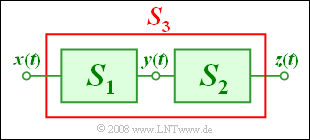Difference between revisions of "Aufgaben:Exercise 2.1: Linear? Or Non-Linear?"
From LNTwww
| Line 49: | Line 49: | ||
| − | { | + | {What conclusions would the observer have to draw if all the information from the information page is known to them? |
|type="[]"} | |type="[]"} | ||
| − | - $S_2$ | + | - $S_2$ is a distortion-free system. |
| − | + $S_2$ | + | + $S_2$ is a linearly distorting system. |
| − | - $S_2$ | + | - $S_2$ is a non-linearly distorting system. |
| − | { | + | {What signal $z(t)$ could arise as a result with the input frequency $f_0 = 10 \ \rm kHz$ ? |
|type="[]"} | |type="[]"} | ||
| − | + | + | + The signal $z(t)$ is zero for all times. |
| − | - | + | - A signal of the form $z(t) = A \cdot {\rm cos}(2\pi \cdot 10 \ {\rm kHz} \cdot t ) ,$ with $A \ne 0.$ |
| − | + | + | + A signal of the form $z(t) = A \cdot {\rm cos}(2\pi \cdot 20 \ {\rm kHz} \cdot t ) ,$ with $A \ne 0.$ |
| Line 68: | Line 68: | ||
{{ML-Kopf}} | {{ML-Kopf}} | ||
| − | '''(1)''' | + | '''(1)''' The following holds due to the characteristic curve with linear and quadratic components: |
:$$y(t) = {2 \, \rm V} \cdot {\rm cos}(2\pi f_0 t ) + {1 \, | :$$y(t) = {2 \, \rm V} \cdot {\rm cos}(2\pi f_0 t ) + {1 \, | ||
\rm V}^{\rm -1} \cdot ({2 \, \rm V})^2 \cdot {\rm cos}^2(2\pi f_0 | \rm V}^{\rm -1} \cdot ({2 \, \rm V})^2 \cdot {\rm cos}^2(2\pi f_0 | ||
| Line 74: | Line 74: | ||
) +{\rm cos}(2\pi \cdot 2f_0 \cdot t ) \big].$$ | ) +{\rm cos}(2\pi \cdot 2f_0 \cdot t ) \big].$$ | ||
| − | * | + | *Therefore, the <u>signal value 6 V</u> occurs at time $t= 0$ . |
Revision as of 21:49, 9 September 2021
We consider the sketched arrangement with input $x(t)$ and output $z(t)$:
- The system $S_1$ is describable by the following equation:
- $$y(t) = x(t) + {1 \, \rm V}^{\rm -1} \cdot x^2(t) .$$
- Nothing else is known about the system $S_2$ with input $y(t)$ and output $z(t)$ .
- The system $S_3$ is the interconnection of $S_1$ and $S_2$.
An oscillation with frequency $f_0 = 5 \ \rm kHz$ is applied to the input:
- $$x(t) = {2 \, \rm V} \cdot {\rm cos}(2\pi f_0 t ) .$$
Hence, at the output of the overall system $S_3$ the following is obtained:
- $$z(t) = {1 \, \rm V} \cdot {\rm sin}(2\pi f_0 t ) .$$
Please note:
- The exercise belongs to the chapter Classification of Distortions.
- The following trigonometric relation is given:
- $$\cos^2(\alpha) = {1}/{2} \cdot \big[ 1 + \cos(2\alpha)\big].$$
Questions
Solution
(1) The following holds due to the characteristic curve with linear and quadratic components:
- $$y(t) = {2 \, \rm V} \cdot {\rm cos}(2\pi f_0 t ) + {1 \, \rm V}^{\rm -1} \cdot ({2 \, \rm V})^2 \cdot {\rm cos}^2(2\pi f_0 t ) = {2 \, \rm V} \cdot \big[ 1 + {\rm cos}(2\pi \cdot f_0 \cdot t ) +{\rm cos}(2\pi \cdot 2f_0 \cdot t ) \big].$$
- Therefore, the signal value 6 V occurs at time $t= 0$ .
(2) Möglich sind die Alternativen 2 und 3:
- Ein ideales System kommt wegen $z(t) ≠ x(t)$ nicht in Frage.
- Bei nur einer Eingangsfrequenz $(f_0 = 5 \ \rm kHz)$ im Testsignal ist keine Aussage möglich, ob eine zweite Frequenzkomponente mit $f \ne f_0$ ebenfalls um $\alpha = 0.5$ gedämpft und um $\tau = T_0/4 = 50 \ µ\rm s$ verzögert würde.
- Ergäbe sich für die zweite Frequenz $\alpha = 0.5$ und $\tau = T_0/4 = 50 \ µ \rm s$, so könnte ein verzerrungsfreies System vorliegen.
- Ergäbe sich für die zweite Frequenzkomponente $\alpha \ne 0.5$ und/oder $\tau \ne T_0/4$, so wäre das System linear verzerrend.
- Die letzte Alternative müsste der Beobachter – obwohl teilweise zutreffend – logischerweise verneinen.
(3) Richtig ist der Lösungsvorschlag 2:
- Der Beobachter würde erkennen, dass $S_2$ ein linear verzerrendes System ist.
- Bei einem verzerrungsfreien System müsste $z(t)$ zusätzlich noch eine Gleichkomponente und eine $10 \ \rm kHz$–Komponente beinhalten,
- bei einem nichtlinear verzerrenden System noch größere Frequenzanteile $($bei Vielfachen von $10 \ \rm kHz)$.
(4) In diesem Fall würde gelten:
- $$y(t) = {2 \, \rm V} \cdot \big[ 1 + {\rm cos}(2\pi \cdot 10 \ {\rm kHz} \cdot t ) +{\rm cos}(2\pi \cdot 20 \ {\rm kHz} \cdot t ) \big].$$
- Das heißt: $Y(f)$ würde Spektrallinien bei $f = 0$, $10 \ \rm kHz$ und $20 \ \rm kHz$ aufweisen.
- Die auf der Angabenseite beschriebene Messung mit $f_0 = 5 \ \rm kHz$ hat aber gezeigt, dass $H_2(f = 0) = H_2(f = 10 \ {\rm kHz}) = 0$ gelten muss.
- Die einzig mögliche Signalform ist somit
- $$z(t) = {2 \, \rm V} \cdot H_2 (f = {20 \, \rm kHz})\cdot {\rm cos}(2\pi \cdot {20 \, \rm kHz} \cdot t ) .$$
- Möglich sind also die Lösungsvorschläge 1 und 3, je nachdem, ob das System $S_2$ die Frequenz $20 \ {\rm kHz}$ unterdrückt oder durchlässt.
